一、初识ES
(一)概念:
ES是一款开源搜索引擎,结合数据可视化【Kibana】、数据抓取【Logstash、Beats】共同集成为ELK(Elastic Stack),ELK被广泛应用于日志数据分析和实时监控等领域,ES是核心组件。
(二)作用: 高效查询搜索内容。
(三)发展史:
1、底层实现是 Lucene,一个Java语言的搜索引擎类库,Apache公司的Top产品之一,由DoungCutting 于 1999 年开发,官方地址:https://lucene.apache.org/
Lucene的优势: 易扩展(可二次开发)、高性能(基于倒排索引)
Lucene的缺点: 只限于Java开发、学习曲线陡峭、不支持水平扩展
2、2004年Shay Banon 基于 Lucene 开发了 Compass
3、2010年Shay Banon 重写了 Compass,重命名为 Elasticsearch
官方地址: https://www.elastic.co/cn/
ES的优势:
- 支持分布式,支持水平扩展
- 提供RESTful接口,可被任何语言调用
(四)ES对比其它搜索引擎的优势
根据搜索引擎技术使用频率排名,前三名是
- ES:开源的分布式搜索引擎(常用)
- Splunk:商业项目
- Solr:Apache的开源资源引擎(常用)
(五)正向索引和倒排索引
1、正向索引
传统数据库(例如MySQL)采用的是正向索引。
- 匹配内容进行逐条查询
- 若不匹配则丢弃,若匹配放入结果集
2、倒排索引
ES使用倒排索引。
- 文档(document): 每条数据就是一个文档
- 词条(term): 文档按照语义分成的词语
倒排索引首先会把索引应用的字段分出各个词条,并且存储在 term-id 键值对表中,若分出的词条相同,则只将当前数据行的id记录到索引表的id字段中。
倒排索引的匹配数据顺序:
- 搜索内容分词
- 获得的词条去词条列表查询id
- 根据文档id查询文档
- 数据存入结果集
(六)ES与MySQL的概念对比
- ES是面向文档存储的,可以是数据库中的一条商品数据,一个订单信息。
- 文档数据会被序列化为json格式后存储在elasticsearch中。
1、ES文档
{"id": 1,“title”: "小米手机","price": 2499
}
{"id": 2,“title”: "华为手机","price": 4699
}
{"id": 3,“title”: "华为小米充电器","price": 49
}
{"id": 4,“title”: "小米手环","price": 299
}
2、ES索引
索引(Index) 是相同类型的文档集合(看文档结构就知道类型是否相同)。
3、MySQL与ES的概念对比
- Table:Index —— 索引,就是文档的集合,类似库的表(Table)
- Row:Document —— 文档,就是数据行,类似数据库中的行(Row),文档是JSON格式
- Column:Field —— Field,就是JSON文档中的属性,类似数据库中的列(Column)
- Schema:Mapping —— Mapping(映射)是索引中的文档约束,例如字段类型约束。类似于数据库的表结构(Schema)
- SQL:DSL —— DSL 是 ES 提供的JSON风格的请求语句,用来才做ES,实现CRUD
4、架构
MySQL架构:擅长事务类型操作,确保数据的安全和一致性。(主要是写操作)
ES 架构:擅长海量数据的搜索、分析、计算。(主要是读操作)
(七)安装ES和kibana
为什么要安装kibana? 因为kibana可以协助我们操作ES。
1、部署单点 ES
(1)创建网络
因为我们还需要部署 kibana 容器,因此需要让es和kibana容器互联,需要创建一个网络。
docker network create es-net

(2)加载镜像
docker pull elasticsearch:7.12.1
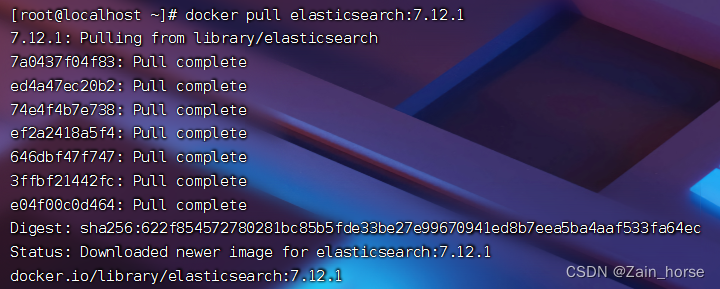
(3)运行ES
运行docker命令,部署单点es:
# -e "cluster.name=es-docker-cluster:设置集群名称
# -e "ES_JAVA_OPTS=-Xms512m -Xmx512m": 设置堆内存大小
# -e "discovery.type=single-node": 配置部署类型为单点
# -v es-data:/usr/share/elasticsearch/data: ES数据挂载点
# -v es-plugins:/usr/share/elasticsearch/plugins: ES插件挂载点
# --network es-net: 容器加载到网络
# -p 9200:9200: 暴露的HTTP访问接口
# -p 9300:9300: 暴露容器访问端口docker run --name es \-e "ES_JAVA_OPTS=-Xms512m -Xmx512m" \-e "discovery.type=single-node" \-v es-data:/usr/share/elasticsearch/data \-v es-plugins:/usr/share/elasticsearch/plugins \--privileged \--network es-net \-p 9200:9200 \-p 9300:9300 \-d elasticsearch:7.12.1
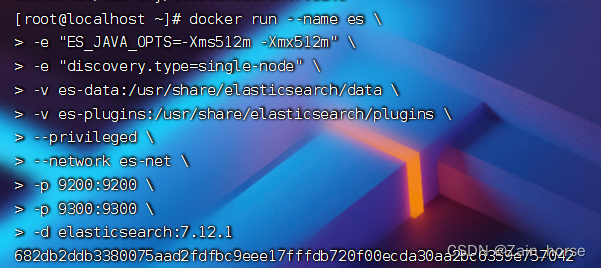
访问9200端口
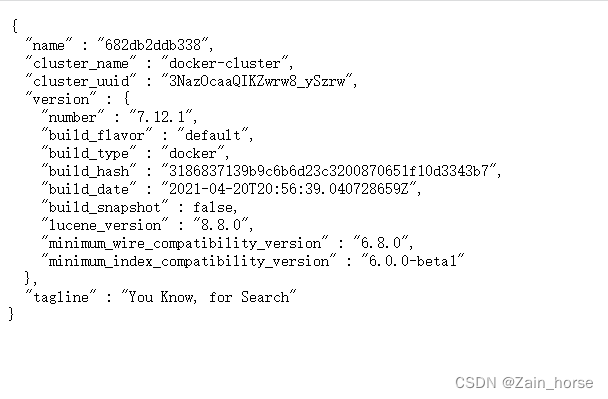
2、部署 kibana
docker pull kibana:7.12.1
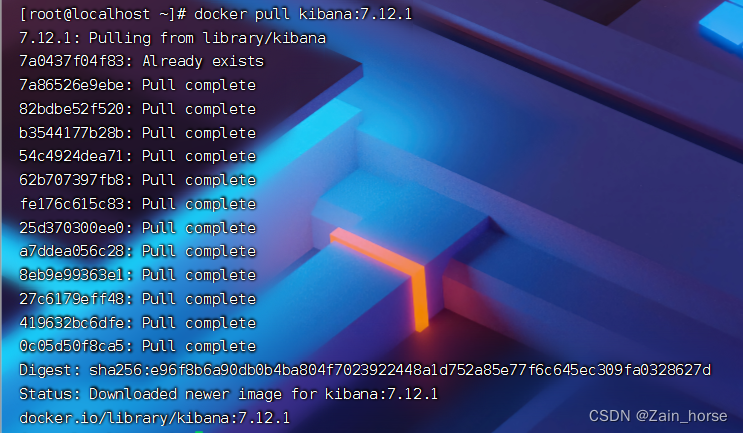
# --network=es-net: 加入到ES的网络中
# -e ELASTICSEARCH_HOSTS=http://es:9200: 配置ES主机地址,因为在同一个网络中,所以可以直接用容器名访问ES
# -p 5601:5601: 端口映射配置
docker run --name kibana \-e ELASTICSEARCH_HOSTS=http://es:9200 \--network=es-net \-p 5601:5601 \-d kibana:7.12.1

访问Kibana控制台
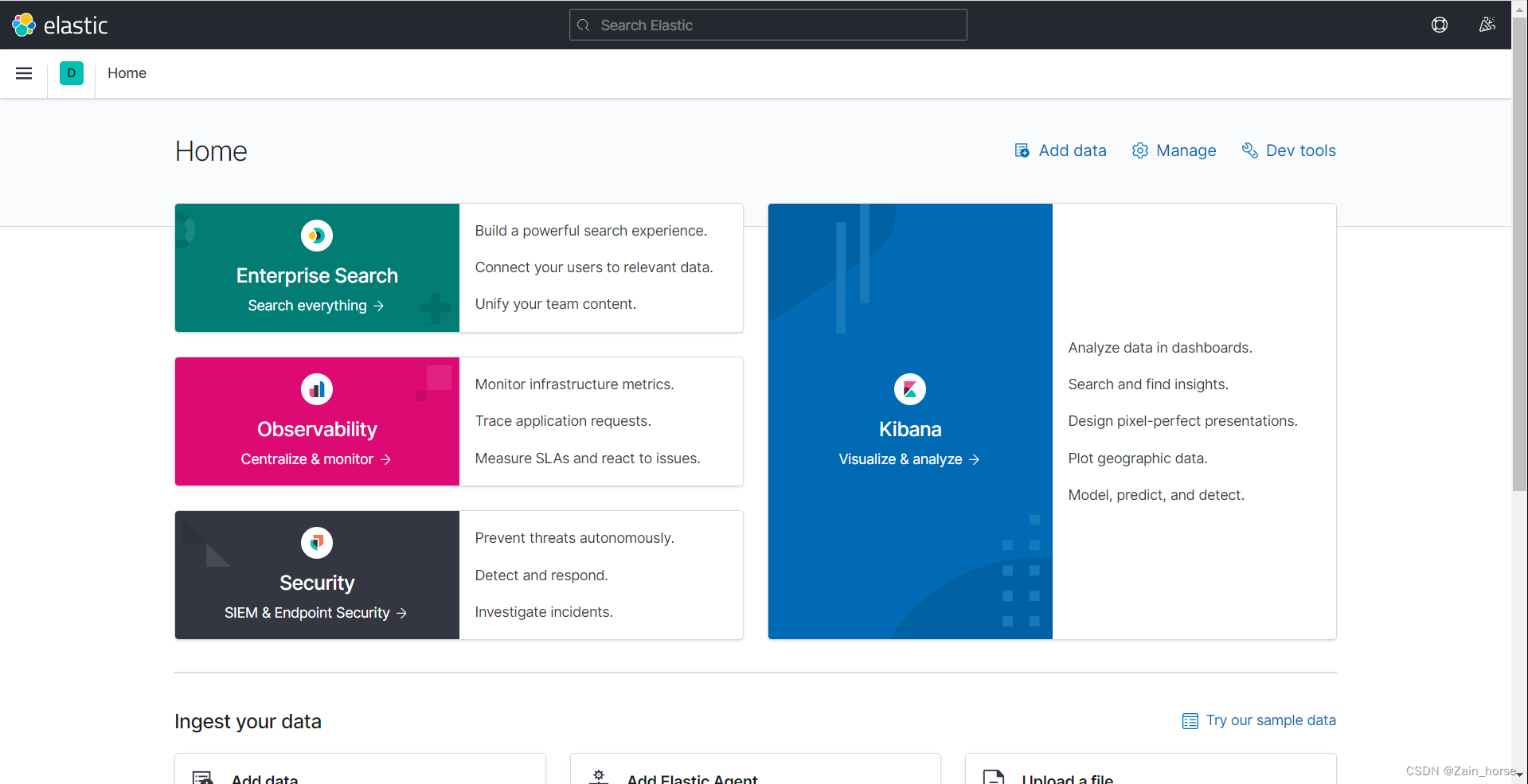
DSL请求台
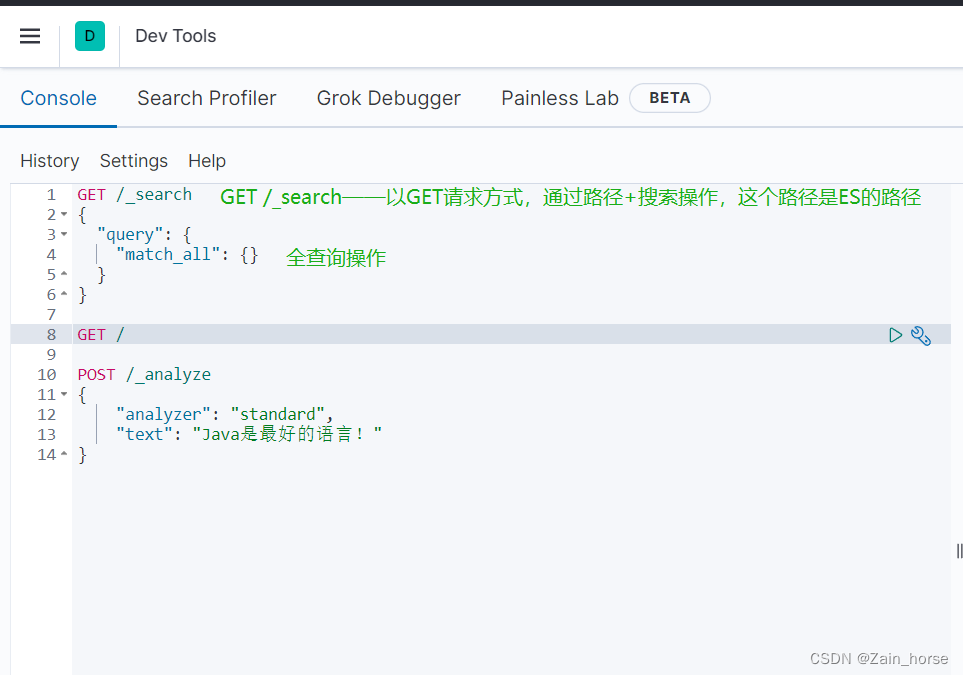
(八)分词器
ES在创建倒排索引时需要对文档分词;在搜索时,需要对用户输入内容分词,但默认的分词规则对中文处理并不好。
我们利用Kibana控制台做个中文测试:
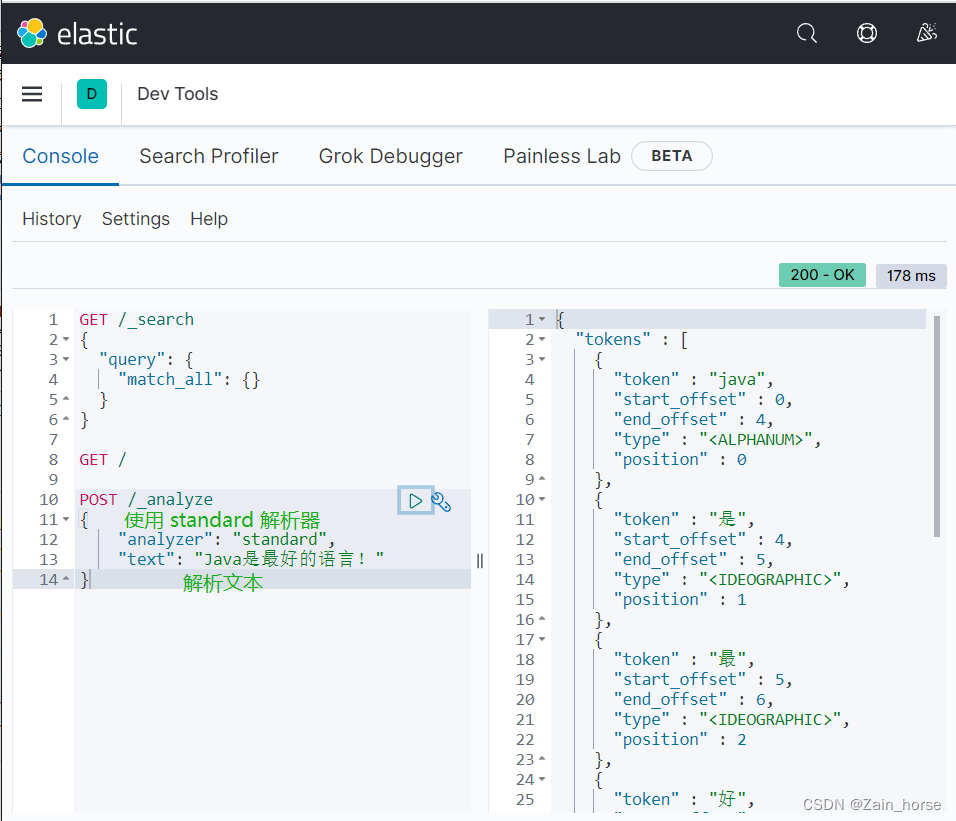
中文分词器 IK
官网:https://github.com/medcl/elasticsearch-analysis-ik
1、部署 IK 分词器
在线安装可能会存在连接拒绝
#进入ES容器
docker exec -it es /bin/bash#下载 IK分词器
./bin/elasticsearch-plugin install https://github.com/medcl/elasticsearch-analysis-ik/releases/download/v7.12.1/elasticsearch-analysis-ik-7.12.1.zip#退出
exit#重启容器
docker restart elasticsearch
离线安装 ik
1、下载 ik.7.12.1,zip
2、解压之后,传输到 elasticsearch-plugins 数据卷
3、重启docker
docker restart es
4、查看IK分词器加载成功
docker logs -f es
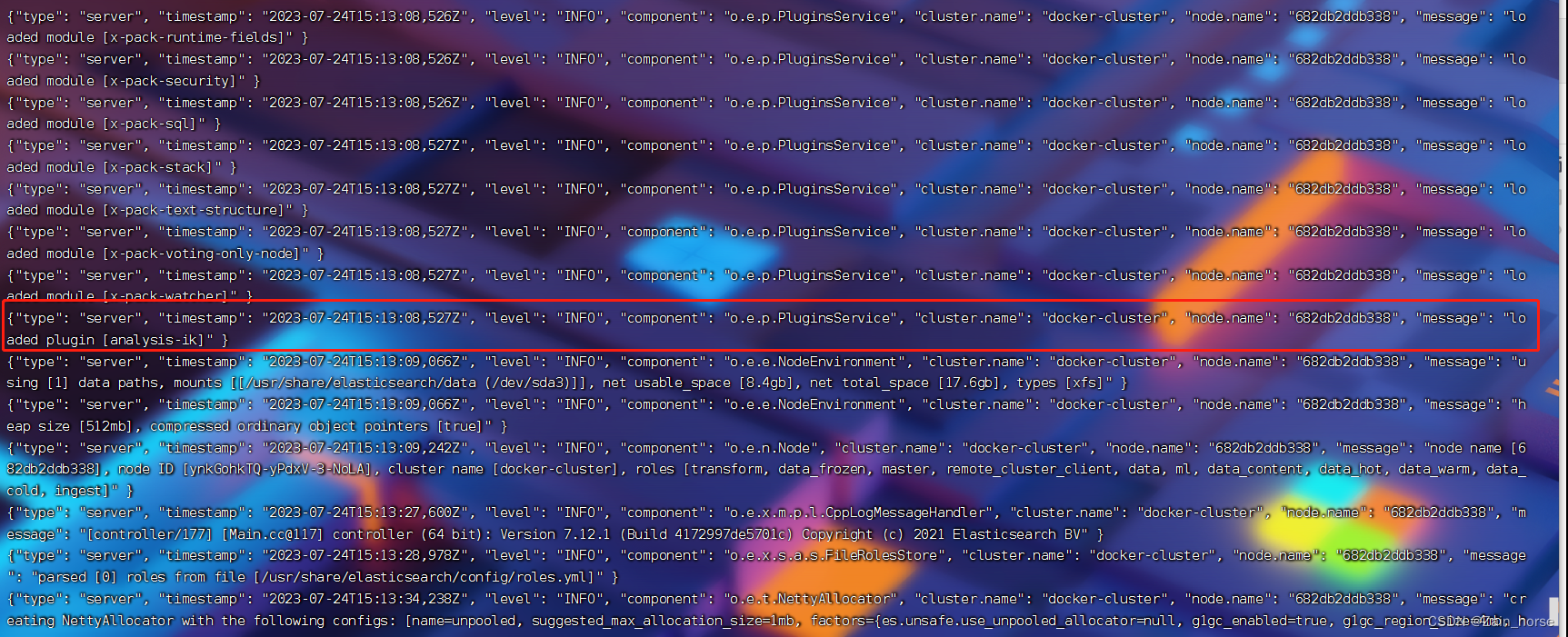
5、测试
-
ik_smart: 粗粒度区分,只拆分一次的方式进行解析。

-
ik_max_word: 最细粒度拆分,最大可能的分出更多的词
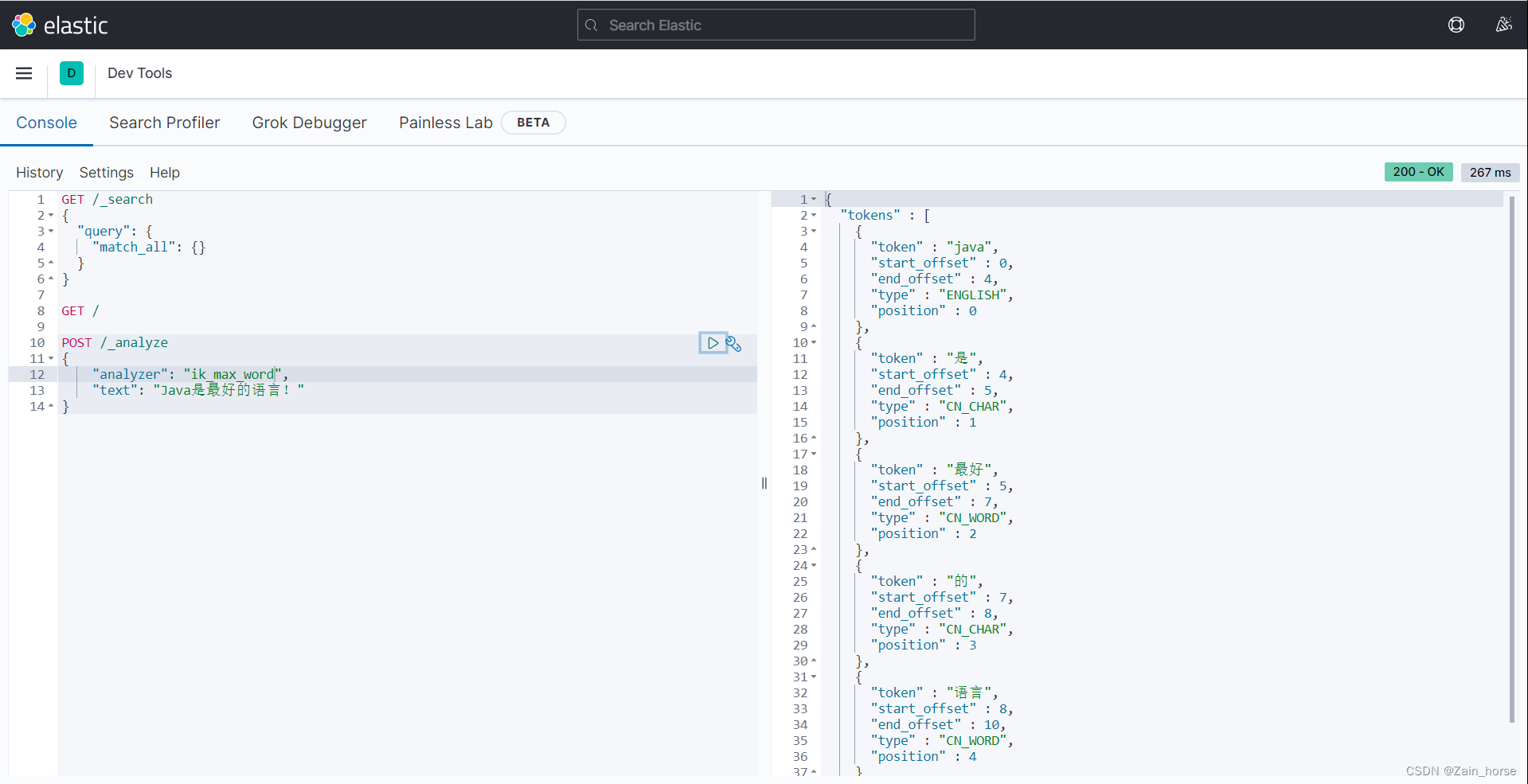
(九)IK分词器的扩展词条和停用词条
IK分词器的底层基于词典进行匹配,若匹配到词典那么就直接拆分,若没有匹配到则不做拆分。
所以我们需要对IK分词进行扩展。
1、修改 IK分词器 的 /config/IKAnalyzer.cfg.xml 文件
<?xml version="1.0" encoding="UTF-8"?>
<!DOCTYPE properties SYSTEM "http://java.sun.com/dtd/properties.dtd">
<properties><comment>IK Analyzer 扩展配置</comment><!--用户可以在这里配置自己的扩展字典 --><entry key="ext_dict">ext.dic</entry><!--用户可以在这里配置自己的扩展停止词字典--><entry key="ext_stopwords">stopword.dic</entry><!--用户可以在这里配置远程扩展字典 --><!-- <entry key="remote_ext_dict">words_location</entry> --><!--用户可以在这里配置远程扩展停止词字典--><!-- <entry key="remote_ext_stopwords">words_location</entry> -->
</properties>
2、创建 ext.dic 和 stopword.dic
这两个文件只是个文本文件,使用回车进行间隔,一个词一行。
这两个文件要配置在config目录下,不然读取不到,插件作者的词典也在config目录下。
3、重启docker
docker restart es
二、操作索引库
(一)mapping映射
常见的mapping属性
- type: 字段数据类型,常见类型有
- 字符串:text(可分词的文本)、keyword(不可分词的文本)
- 数值: byte、short、integer、long、float、double
- 布尔: boolean
- 日期: date
- 对象: object
- geo_point: 由经度和维度确认的点,例如"32.8138,120.58558"
- geo_shape: 多个点复合的几何图形,例如一条直线LINESTRING(-77.06581831,-77.008463181)
- index: 是否创建索引,默认为true
- analyzer: 使用的分词器
- properties: 该字段的子字段,例如对象中的属性
- text: 分词文本
关于数组集合问题: mapping 支持单个类型能有多个。
(二)创建索引库
ES通过 RESTful 请求操作索引库、文档。请求内容用DSL语句来表示。
创建索引库和mapping 的DSL语法如下:
PUT /test
{"mappings": {"properties": {"info": {"type": "text""analyzer": "ik_smart},"email": {"type": "keyword","index": "false"},"name": {"type": "object","properties": {"firstName": {"type": "keyword"},"lastName": {"type": "keyword"}}}}}
}
常见成功效果
{"acknowledged" : true,"shards_acknowledged" : true,"index" : "test"
}
这里还有个小技巧: 当我们需要多字段搜索可以使用 copy_to进行属性拷贝。
"all": {"type": "text","analyzer: "ik_max_word"
},
"brand": {"type": "keyword","copy_to": "all"
}
(三)查看、删除、修改索引库
1、查看索引库
GET /test
使用效果
{"test" : {"aliases" : { },"mappings" : {"properties" : {"email" : {"type" : "keyword","index" : false},"info" : {"type" : "text","analyzer" : "ik_smart"},"name" : {"properties" : {"firstName" : {"type" : "keyword"},"lastName" : {"type" : "keyword"}}}}},"settings" : {"index" : {"routing" : {"allocation" : {"include" : {"_tier_preference" : "data_content"}}},"number_of_shards" : "1","provided_name" : "test","creation_date" : "1690214456747","number_of_replicas" : "1","uuid" : "IIdXK-pATYOns4c8BDoaMw","version" : {"created" : "7120199"}}}}
}2、删除索引库
DELETE /test
使用效果
删除成功效果
{"acknowledged" : true
}再次查询索引库
{"error" : {"root_cause" : [{"type" : "index_not_found_exception","reason" : "no such index [test]","resource.type" : "index_or_alias","resource.id" : "test","index_uuid" : "_na_","index" : "test"}],"type" : "index_not_found_exception","reason" : "no such index [test]","resource.type" : "index_or_alias","resource.id" : "test","index_uuid" : "_na_","index" : "test"},"status" : 404
}
3、修改索引库(只能添加字段)
PUT /test/_mapping
{"properties": {"age": {"type": "integer}}
}
使用效果
新增成功
{"acknowledged" : true
}
再次查询/test索引库
{"test" : {"aliases" : { },"mappings" : {"properties" : {"age" : {"type" : "integer"},"email" : {"type" : "keyword","index" : false},"info" : {"type" : "text","analyzer" : "ik_smart"},"name" : {"properties" : {"firstName" : {"type" : "keyword"},"lastName" : {"type" : "keyword"}}}}},"settings" : {"index" : {"routing" : {"allocation" : {"include" : {"_tier_preference" : "data_content"}}},"number_of_shards" : "1","provided_name" : "test","creation_date" : "1690214957185","number_of_replicas" : "1","uuid" : "HeoHP6GYS-uovI1DQyxEsg","version" : {"created" : "7120199"}}}}
}
三、文档操作
(一)新增文档
POST /test/_doc/1
{"info": "Java是最好的语言","age": 18,"email": :"zengoo@163.com","name": {"firstName": "Zengoo","lastName": "En"}
}
使用效果
{"_index" : "test","_type" : "_doc","_id" : "1","_version" : 1,"result" : "created","_shards" : {"total" : 2,"successful" : 1,"failed" : 0},"_seq_no" : 0,"_primary_term" : 1
}
(二)删除文档
DELETE /test/_doc/1
使用效果
删除成功
{"_index" : "test","_type" : "_doc","_id" : "1","_version" : 2,"result" : "deleted","_shards" : {"total" : 2,"successful" : 1,"failed" : 0},"_seq_no" : 1,"_primary_term" : 1
}再次查询
{"_index" : "test","_type" : "_doc","_id" : "1","found" : false
}
(三)修改文档
PUT /test/_doc/1
{"info": "这是我的ES拆分Demo"
}
使用效果
修改成功
{"_index" : "test","_type" : "_doc","_id" : "1","_version" : 2,"result" : "updated","_shards" : {"total" : 2,"successful" : 1,"failed" : 0},"_seq_no" : 3,"_primary_term" : 1
}再次查询
{"_index" : "test","_type" : "_doc","_id" : "1","_version" : 2,"_seq_no" : 3,"_primary_term" : 1,"found" : true,"_source" : {"info" : "这是我的ES拆分Demo"}
}
我们可以看到直接使用PUT进行修改,会直接覆盖原有的文档。
所以我们使用第二种修改方法。
POST /test/_update/1
{"doc": {"info": "这是我的ES拆分Demo"}
}
使用效果
更新成功
{"_index" : "test","_type" : "_doc","_id" : "1","_version" : 11,"result" : "updated","_shards" : {"total" : 2,"successful" : 1,"failed" : 0},"_seq_no" : 12,"_primary_term" : 1
}查询文档
{"_index" : "test","_type" : "_doc","_id" : "1","_version" : 11,"_seq_no" : 12,"_primary_term" : 1,"found" : true,"_source" : {"info" : "这是我的ES拆分Demo","age" : 18,"email" : "zengoo@163.com","name" : {"firstName" : "Zengoo","lastName" : "En"}}
}
(四)查询文档
GET /test/_doc/1
使用效果
{"_index" : "test","_type" : "_doc","_id" : "1","_version" : 1,"_seq_no" : 0,"_primary_term" : 1,"found" : true,"_source" : {"info" : "Java是最好的语言","age" : 18,"email" : "zengoo@163.com","name" : {"firstName" : "Zengoo","lastName" : "En"}}
}
四、RestClient操作索引库
(一)RestClient
ES官方提供了不同语言的ES客户端,这些客户端的本质是组装DSL语句,通过HTTP请求发送给ES。
官方文档: https://www.elastic.co/guide/en/elasticsearch/client/index.html
(二)安装RestClient
安装RestHighLevelClient依赖
<dependency><groupId>org.elasticsearch.client</groupId><artifactId>elasticsearch-rest-hight-level-client</artifatId>
</dependency>
覆盖默认的ES版本
<properties><elasticsearch.version>7.12.1</elasticsearch.version>
</properties>
初始化RestHighLevelClient
RestHightLevelClient client = new RestHighLevelClient(RestClient.builder(HttpHost.create("http://192.168.92.131:9200")));
(三)RestClient操作索引库
创建索引库
//1、创建Request对象
CreateIndexRequest request = new CreateIndexRequest("test");
//2、请求参数,
//MAPPING_TEMPLATE 是静态常量字符串,描述的是自定义的创建索引库的DSL语句
//XContentType.JSON 是指定DSL语句以JSON格式化
request.source(MAPPING_TEMPLATE, XContentType.JSON);
//3、发起请求
//indices, 返回对象中包含的所有索引库操作方法
//RequestOptions.DEFAULT, 默认请求头
client.indices().create(request, RequestOptions.DEFAULT);
删除索引库
CreateIndexRequest request = new CreateIndexRequest("test");
client.indices().delete(request, RequestOptions.DEFAULT);
查询索引库存在状态
CreateIndexRequest request = new CreateIndexRequest("test");
boolean status = client.indices().exists(request, RequestOptions.DEFAULT);
(四)RestClient操作数据文档
创建文档
//根据ID查询数据, hotelService的自定义的方法getById
Hotel hotel = hotelService.getById(1L);
//转换类型,由于数据库类型与DSL类型有差异,所以需要定义一个转换类进行属性转换,即转换类构造器改造实体类。
HotelDoc hotelDoc = new HotelDoc(hotel);
//1、创建Request对象
IndexRequest request = new IndexRequest("test").id(hotel.getId().toString());
//2、准备JSON文档, 通过fastjson快速转换成json格式文本
request.source(JSON.toJSONString(hotelDoc, XContentType.JSON);
//3、发送请求
//index, 就是发送请求的那个索引
client.index(request, RequestOptions.DEFAULT);
查询文档
//1、创建request对象
GetRequest request = new GetRequest("test").id("1");
//2、发送请求,得到结果
GetResponse response = client.get(request, RequestOptions.DEFAULT);
//3、解析结果
String json = response.getSourceAsString();
System.out.println(JSON.parseObject(json, HotelDoc.class));
删除文档
//1、创建request对象
DeleteRequest request = new DeleteRequest("test").id("1");
//2、发送请求,得到结果
client.delete(request, RequestOptions.DEFAULT);
修改文档
方式一:全量修改
方式二:局部修改
//1、创建Request对象
UpdateRequest request = new UpdateRequest("test","1");
//2、准备参数,每两个参数为一对
request.doc("age": 18,"name": "Rose"
);
//3、更新文档
client.update(request, RequestOptions.DEFAULT);
批量导入文档
使用思路
1、通过mybatis查询数据库数据
2、实体类数据转换成文档类型数据
3、RestClient利用Bulk批处理
//1、创建Bulk请求
BulkRequest request = new BulkRequest();//2、添加批量处理请求
for(Hotel hotel: hotels){HotelDoc hotelDoc = new HotelDoc(hotel);request.add(new IndexRequest("hotel").id(hotel.getId().toString()).source(JSON.tJSONString(hotelDoc),XContentType.JSON));
}//3、发起请求
client.bulk(request, RequestOptions.DEFAULT);




)


)
自学)

】)







)
)